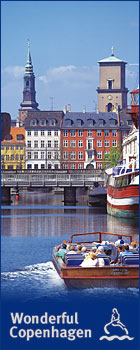Denmark was one of the world’s earliest leaders in pro-gay rights. My first visit many years ago as a not-yet-gay tourist pleased and teased me with its sexy shops and magazines and colorful night life. It opened my eyes to more to my own truth when a friendly stranger swept me away for a night of dazzling delight. Presented here are two stories by guest authors who briefly sketch
different angles of the scene in Denmark. The first is a playful party view and the second is critical of the country’s politcal conservatives.
Also see:
Gay Denmark News & Reports 2004 to present
Gay Greenland story
Gay Greenland News & Reports 2007 to present
(1)
From OutUK
http://www.outuk.com/outgoing/europe/copenhagen/index.html
Updated July 2008
Denmark is among the gay-friendliest nations in the world
By Andrew Collins 
It may not be the first city gay travellers think of when they head for a European capital, but Denmark’s liberal capital city of Copenhagen has been making an international name for itself in recent years. A centre of cutting-edge home-furnishing and architectural design, this compact, handsomely preserved city with more than eight centuries of history has one of the continent’s friendliest and most fun-loving gay scenes. It’s a city that embraces the avant-garde and yet cultivates a warm, old-fashioned sense of humility and hospitality – in Copenhagen, you are never made to feel like an outsider.
Politically, Denmark is among the gay-friendliest nations in the world; the government began recognizing same-sex marriages in 1989 and it legalized adoption by gay parents in 1999.
In 1948, one of Europe’s first gay political organizations, the National Association for Gays and Lesbians (LBL), opened here. The organization continues to be an invaluable community resource and has a fascinating and comprehensive archive. In Copenhagen, openly gay citizens occupy numerous prominent positions in society – few Danes bat an eyelash at the sight of two gay women or men strolling by, except perhaps as an act of flirtation.
Apart from being culturally rich and exceedingly gay-friendly, Copenhagen offers added benefits. The costs of most goods and services are comparable or less than in the UK because of the strong pound and additionally, English is spoken and understood by most Danes, especially in Copenhagen. Many periodicals are written in English, including the useful Pan’s Guide to Gay and Lesbian Denmark and the Copenhagen Gay Map.
This is a compact and eye-pleasing city that can easily be explored on foot. Be sure to spend an afternoon strolling along Strøget, a pedestrian way packed with chic shops and cafes. Kongens Nytorv (King New Square) is a great spot to people-watch; just off it lies charming Nyhavn (New Harbor), where canal boats can be hired.
While you don’t need days to see the city’s sites, Copenhagen’s larger-than-life Tivoli park could keep you entertained for a week or more. This festive venue of live-music concerts, theater, gardens, duck ponds, restaurants, and other spirited goings-on is open May through September (plus the two weeks leading up to Christmas). Other must-sees include: Christiansborg Castle, an immense 15th-century fortification whose grounds contain government buildings and royal reception halls; the National Museum, the city’s archive of antiquities – from not just Denmark but the entire world; and the highly regarded and recently renovated National Art Gallery, notable for its thousands of Danish works but also for its international collections.
Copenhagen enjoys one of Northern Europe’s most innovative and accomplished culinary reputations. One of the hottest spots is Gendarmen Restaurant, where a changing menu offers such inspired fare as roasted leg of venison with foie-gras-mashed potatoes, tarragon, and a cherry glaze. The trendy Flyvefisken serves spicy Thai food at reasonable prices. Among gay-popular eateries, Queen Victoria is one of the most atmospheric – it’s in a restored building that dates to the 14th century.
Most gay nightlife is concentrated in the city’s bohemian Old Town. Things don’t usually get going in Copenhagen until late in the evening, after 11 or even midnight, and most bars keep going well into the wee hours. Just about every gay boy in Copenhagen seems to end up eventually at Pan, where you’ll find four levels of posing, mingling, and cruising – including a pair of dance floors (one spinning retro, the other house and trance). The disco section is open only weekends, but you can enjoy the side bar and cafe nightly.
Popular both with lesbians and gay men, Heaven Cafe consists of a cheerful but compact downstairs cafe with movie posters decoupaged along the ceiling – it’s popular in the early evening during "heavenly hour," when drinks flow copiously (and cheaply). On busier evenings the second-floor restaurant opens, serving an affordable mix of bistro favorites, sandwiches, burgers, crepes, and salads.
A two-level gay bar and brasserie with a faux-marble floor and exposed-brick walls, Cafe Sebastian is among the most inviting places to while away an evening – the staff and crowd are stylish yet unpretentious, the ambience refined but festive.
Along similar lines, Kelleen opened inside an elegant 1790s building with floor-to-ceiling windows and blond-wood furnishings in December 2000 – this mostly gay/lesbian hangout draws a good-looking mix of hipsters and students.
Centralhjørnet is a riotously fun locals’ bar with kitschy decor and retro music blaring out of its jukebox – this is one of the oldest gay bars in the world, having opened in the 1920s. Festive Can-Can draws a mostly over-40 crowd and is among the most welcoming gay taverns in town. The outlandish Cosy Bar stays open later than most and presents wild drag shows. A lively and somewhat cruisy late-night bar with dark and cozy confines, Never Mind tends to draw a mostly male late-20s-to-mid-40s bunch. Rough-and-ready leather types and bears favor the aptly named Men’s Bar.
For more heart-pumping action, gay men in Copenhagen head to the Amigo Sauna, which is open from noon until 7 a.m. the next day and has been going strong since the mid-’70s. You can also catch porn flicks at a handful of sex clubs, including Loke and Body Bio.
The city also has a handful of gay-oriented accommodations, including Copenhagen Rainbow, which opened along the fabulous Strøget in August 2000. Other reasonably priced gay options include At Carstens Guest House and the Hotel Windsor.
Copenhagen is a year-round destination, although most visitors come during the warmer months, in part because this is when Tivoli is open. A popular time to visit among lesbians and gays is mid-August, when you can attend the city’s lively and fun Mermaid Pride Festival – a parade of lesbians and gays proceeds through central Copenhagen, attracting throngs of supporters.
In October, the city hosts the prestigious nine-day Copenhagen Gay and Lesbian Film Festival. But even in the rather dark depths of winter, with an abundance cozy gay bars and chatter-filled restaurants and boutiques, you’ll find plenty of ways to keep warm in Copenhagen.
Andrew Collins authored Fodor’s Gay Guide to the USA, the Connecticut Handbook, and six regional gay guides for Fodor’s. He can be reached here at OutUK or direct at GayFodors@aol.com.
(2)
From: Pan Guide to Gay & Lesbian Denmark
Danish Registered Partnerships
By Søren Laursen
In 1989 Denmark took a step towards recognizing a broader definition of the concept of family by introducing the registered partnership, i.e. a “marriage” between two persons of the same sex. As for taxation, social security, inheritance, etc., it had all the implications of traditional, heterosexual marriage.
The only restrictions were all matters concerning children, and the requirement that one of the partners be a Danish citizen, living in Denmark.
In 1999, some of these restrictions were removed: step-child adoption was made possible: now a person in a registered partnership may adopt the child(ren) of his/her partner.
Furthermore, two non-Danish citizens may now enter into registered partnership,as long as they fullfil the requirement of having lived in Denmark for at least two years. (A similar amendment was introduced in Iceland in the early summer of 2000).
The unholy matrimony?
(Denmark has no division between state and church – being a very secular and pragmatic nation, we operate with the concept of a national/state church, the Lutheran “Folkekirke (People’s Church)”, whose upkeep is paid for by the Danish population through the income tax.).
Discussions with and amongst the bishops of the “Folkekirke“ on adopting a church ritual for the registered partnership went on for years.
A sub-commitee, commissioned by the bishops, handed in a very progressive report, containing three different suggestions on how to deal with the registered partnership. One suggestion was the introduction of a new ritual, aimed at people entering the partnership – thus recognizing that this was a new institution in family life.
Unfortunately, the bishops were not up to this, and ended up opting for a rather informal solution which allows only an ad hoc ritual, merely consisting of the pastor’s being able to give a blessing to the partnership – and in no way meaning it to resemble the ritual for marriage.
Several pastors, however, disregard this restriction and offer a solemn and satisfying procedure to people wishing to enter the registered partnership in the eyes of God:
Firstly, the couple is registered by a deputy from the mayor’s office – this ceremony takes place in the antechamber of the church. After being properly “registered”, the couple and their guests enter the church where the pastor performs a ceremony similar to an ordinary heterosexual church wedding.
Needless to say, this is considered to be mere heresy by the right wing of the Church – but as of yet, no measures have been taken to stop or prevent progressive pastors from performing the ceremony.
The power of the right wing of the Church is not to be taken lightly, though: A sign of this is the fact that when the Faeroe Islands (a self-governing North Atlantic archipelago which is a part of the Kingdom of Denmark) recently celebrated the 1000-year anniversary of Christianity and thus invited the Danish bishops to give sermons in a number of churches on the islands – the two more openly pro-gay bishops were asked to stay at home …
The futile recognition
Even though it may seem as if Denmark has become a gay haven, it has recently become evident that the acceptance of lesbians and gays and the consequential distribution of civil and minority rights to us only goes so far.
A very harsh debate in the Folketing (the Danish parliament) on assisted fertilization has shown that, after all, lesbians and gays are to be considered second class citizens: We are not considered suitable parents – and a majority of members of the Folketing has no qualms in stating this unequivocally.
There are no signs that this climate of parliamentary ill-will is going to change in the coming years. On the contrary, a number of politicians have declared open war.
And that they will get!
















